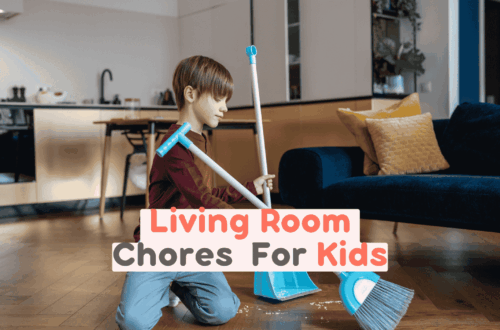Every evening feels the same: you ask for the toys to be picked up, your child stalls, you repeat the request louder, and the inevitable argument begins. Sound familiar? For many parents, the real problem isn’t the chore — it’s the motivation. That’s where storytelling to motivate kids’ chores comes in: by turning tasks into short, imaginative adventures, you transform resistance into excitement. Instead of nagging, you invite your child into a world where the job is part of a mission, a mystery, or a hero’s quest, and chores suddenly feel purposeful and fun.
Want a simple way to get started? Download our free, age-appropriate printable chore charts to pair with story prompts and make the transition from procrastination to participation easy: Free Printable Chore Charts by Age.
Why Storytelling to Motivate Kids Chores Works: The Psychology Behind It
Stories are how humans make sense of the world. Research in behavioral science and communication shows that narrative formats can increase engagement and change behavior because they draw people in and reduce resistance. Self-Determination Theory (Deci & Ryan) highlights that kids are more likely to do tasks when they feel autonomous and competent — storytelling supports both by giving choice and a sense of mastery (Deci & Ryan, 2000).
Additionally, narrative communication has been used successfully to encourage behavior change in health and education settings: stories lower defensiveness and make lessons memorable (Hinyard & Kreuter, 2007). In short, reframing chores as short stories or missions taps into kids’ imagination and intrinsic motivation — a much better foundation than rewards or threats alone.
Storytelling to Motivate Kids Chores: Quick Story Prompts & Chore Ideas
Below are easy-to-use story frameworks and concrete chore pairings by age. Each prompt includes a one-line setup, the chore to attach, and a short script you can say. Use these straight away or personalize them to your child’s favorite characters.
Storytelling Prompts for Toddlers (Ages 2–4)
- Prompt: “The Teddy Rescue” — Toys have lost their way.
- Chore: Put stuffed animals back in the basket.
- Script: “Teddy is lost in the jungle! Can you help him get back to the cozy cave (the basket) before the moon comes up?”
- Prompt: “Painting Patrol” — The art supplies need a home.
- Chore: Put crayons and paper away.
- Script: “The crayons are tired and need to sleep in their house. Can you tuck them in?”
Storytelling Ideas to Motivate Chores for Ages 5–7
- Prompt: “Treasure Hunt” — Maps and clues lead to the treasure (clean room).
- Chore: Put clothes in hamper, books on shelf, toys in bins.
- Script: “X marks the spot under the bed — find the blue sock and place it in the hamper to unlock the next clue!”
- Prompt: “Super Speed Sweep” — A superhero minute.
- Chore: Quick tidy-up in 3 minutes.
- Script: “Activate Super Speed! You have three minutes to save the city from clutter — go!”
- Chore: Quick tidy-up in 3 minutes.
For middle elementary (ages 8–10)
- Prompt: “Detective’s Case File” — Solve the Case of the Missing Socks.
- Chore: Sort laundry, match socks, fold simple items.
- Script: “You’re Detective Riley. Clue #1: A lone sock was spotted near the couch. Can you process the evidence and return it to its match?”
- Prompt: “Chef’s Challenge” — The kitchen needs prep for the feast.
- Chore: Wipe counters, set placemats, put away dishes.
- Script: “Head Chef, we need tidy counters before the royal guests arrive. Are your hands ready to work their magic?”
For tweens (ages 11+)
- Prompt: “Mission Briefing” — You’re part of a squad keeping the house operational.
- Chore: Take out trash, vacuum common areas, prep lunch for next day.
- Script: “Mission: Keep Base Clean. Your objectives are simple: clear the trash, secure the living room, and report back for debrief.”
- Prompt: “Start-Up Founder” — Run your mini business (responsibility & money skills).
- Chore: Manage weekly recycling, organize family calendar, or oversee pet care.
- Script: “You’re CEO of Team Home. This week your KPI is clean counters and a full recycling bin. Let’s hit those targets.”
After trying a few prompts, print a themed chart and stick it on the fridge so the story mission becomes a visible routine: Get the free printable chore charts.
Tips and Mistakes When Using Storytelling to Motivate Kids Chores
- Keep stories short. A two-sentence setup is enough. Too long and the task loses momentum.
- Give real choices. Offer two story missions and let your child pick — autonomy boosts buy-in (see Deci & Ryan above).
- Be consistent, not theatrical every time. Use stories for transitions or low-motivation tasks rather than all chores, so the device stays fresh.
- Avoid bribing with big rewards. Story-based motivation supports intrinsic interest; large external rewards can undermine that over time.
- Match the story to age and temperament. Some kids love high-energy heroic tales; others prefer mystery or helping narratives.
- Don’t over-summarize progress. Brief praise (“Great detective work!”) reinforces responsibility without turning the story into a performance for you.
Tracking Storytelling Chores for Kids — Make Stories Stick with Kikaroo
Stories are great for starting a habit, but consistent tracking helps it become real responsibility and builds independence. The Kikaroo app pairs chore tracking with child-friendly visuals, custom tasks, and gentle reminders so your child can see their missions and progress in one place. It works well alongside storytelling: create a weekly theme in the app (“Space Week” or “Detective Week”), assign story-based tasks, and let kids mark missions complete — they get the autonomy and you get fewer reminders.
Explore how Kikaroo turns imaginative missions into lasting routines at Kikaroo.
Internal links & further reading
- Chores by age guide — Match story complexity and chores to your child’s stage.
- Tips to make chores easier — Other practical strategies to reduce nagging.
- Chore chart tools and apps — How to blend printable charts with digital tracking.
Conclusion
Using Storytelling to Motivate Chores turns boring tasks into meaningful mini-adventures that help kids build responsibility and independence. The approach leans on real psychological principles — choice, competence, and narrative engagement — to make chores less of a battle and more of a bonding moment. Start small: pick one short prompt, attach it to a single task, and track progress with a printable chart or the Kikaroo app to make it part of your family routine.
Ready to try it? Download the free printable chore charts and pair them with one of the story prompts today: Free Printable Chore Charts by Age. To move from paper to playful digital tracking, check out the Kikaroo app at Kikaroo.
FAQ
Q: How often should I use storytelling for chores?
A: Use stories for transitions, low-motivation tasks, or when you want to build a habit. A few times a week keeps the method effective; avoid overuse so it stays special.
Q: Will stories stop working if kids figure them out?
A: Stories can lose novelty, so refresh themes, let kids co-create narratives, or increase complexity with age-appropriate missions to maintain interest.
Q: Can I combine stories with rewards?
A: Yes — but prefer small, reinforcing rewards (stickers, privileges) rather than large extrinsic incentives. The goal is to build intrinsic responsibility over time.

 Home
Home Features
Features Testimonials
Testimonials Downloads
Downloads FAQ
FAQ Blog
Blog








